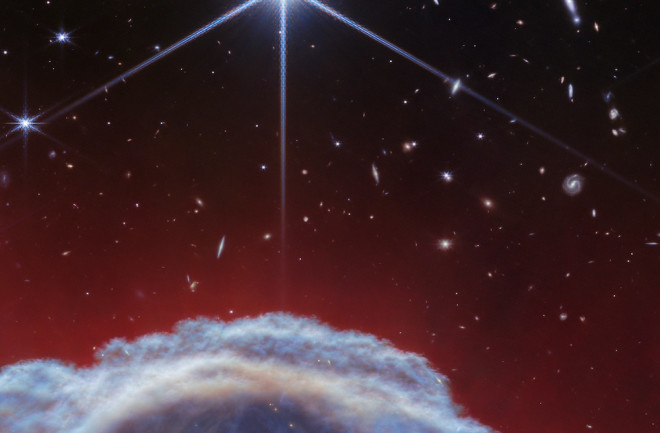Since December 2021, the James Webb Space Telescope (JWST) has unlocked various secrets of our universe. From providing newer images of galaxies taken by the Hubble Space Telescope to enlightening experts on supernova remnants and peering into the early universe, the spacecraft has already discovered so much.
Below are the latest and greatest images that NASA has released from the JWST.
The Latest James Webb Telescope Image: April 29, 2024
The JWST has taken a close-up of the Horsehead Nebula, or Barnard 33, in gorgeous detail. The Horsehead Nebula, found in the constellation Orion, is about 1,300 light years from Earth. In the zoomed-in image, JWST captured the nebula’s wispy filaments of gas, lit up by radiation from nearby stars. A study on the observations was published this month in Astronomy & Astrophysics.
Galactic Chess Piece
While other space telescopes such as Euclid and the Hubble Space Telescope have captured images of the nebula’s most famous feature, a cloud that resembles a knight chess piece, the new JWST image offers a unique perspective. It is a close-up of the top of the Horsehead’s ‘mane.’
By zooming in on this part of the nebula, scientists can gain insights into how the nebula’s dust blocks and radiates light. These details might also help the team understand how the nebula was shaped. The cold gaseous structure glows because it’s illuminated by a nearby star called Sigma Orionis.
Read More: 19 Stunning Galaxy Images from the James Webb Space Telescope
13 Other Mesmerizing James Webb Telescope Images
Here are some of the first images from the JWST that have kept us captivated.
1. First Released Image
JWST's first deep field image captured the distortion of various galaxies. Some galaxies appear smudged because of gravitational lensing.
2. NGC 7469's Ring and Diffraction Spikes
The red diffraction spikes coming from the middle of the galaxy are caused by the galaxy's active galactic nucleus (AGN). The AGN emits light from the dust and gas that is pulled into the center's black hole.
3. Merging Galaxies: II ZW 96
This galaxy lies 500 million light-years from Earth. The galaxies are in the process of merging and is the reason for their distorted shapes.
4. The Cosmic Hourglass of a New Protostar
JWST can see in infrared and is why we can see the billowing hour-glass shape of this young protostar. Eventually, this protostar will become a main sequence star after it gathers enough mass to spark the hydrogen fusion process.
5. The Tarantula Nebula
The middle of the the Tarantula nebula is carved out from the radiation emitted from the group of young blue massive stars seen in the center.
6. Auroras on Jupiter
This fantastic image was processed by citizen scientist, Judy Schmidt.
7. Supernova remnant Cassiopeia A
This supernova remnant is one of the most studied in all of the galaxies. JWST's new image gives us a closer look at the details of the remnant's expanding shell of dust and gas.
8. The Ring Nebula
The Ring nebula is a type of planetary nebula located 2,500 light-years away from Earth.
9. Saturn's Glowing Rings and Moons
The image is dazzling, but was originally intended to see if JWST could show faint moons and rings around Saturn. If any new moons show up, it can help researchers get a clearer picture of Saturn's past.
10. Orion Bar in the Orion Nebula
The Orion Bar is about 1,300 light years away from Earth. JWST is studying this part of the nebula to see how massive stars affect their environments.
11. Wolf-Raylet star WR 124
This massive star is located 15,000 light years away from Earth in the Sagitta constellation. Wolf-Rayet stars are some of the most vibrant and biggest, detectable stars. These stars only stay in this form for a brief moment before they go supernova.
12. The Cartwheel Galaxy
The Cartwheel galaxy obtained its wagon wheel shape from a high-speed crash between a big spiral galaxy and a smaller galaxy not picture in the image. It is located 500 million light years from Earth.
13. JWST Pillars of Creation
The Pillars of Creation are made of cold hydrogen gas and dust. This section is only a small part of the Eagle Nebula. It's located about 6,500 light years from Earth.
Article Sources
Our writers at Discovermagazine.com use peer-reviewed studies and high-quality sources for our articles, and our editors review for scientific accuracy and editorial standards. Review the sources used below for this article:
NASA. James Webb Telescope.
Elizabeth Gamillo is a staff writer for Discover and Astronomy. She has written for Science magazine as their 2018 AAAS Diverse Voices in Science Journalism Intern and was a daily contributor for Smithsonian. She is a graduate student in MIT's Graduate Program in Science Writing.

